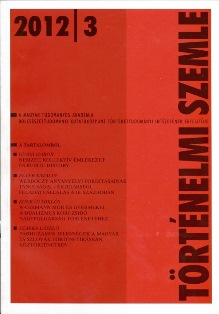Wahrmann Mór és gyermekei. Adalék a dualizmus kori zsidó nagypolgárság történetéhez
Mór Wahrmann and His Children. A Chapter in the History of the Jewish Bourgeoisie in the Dualist Period
Author(s): Miklós KonrádSubject(s): History
Published by: Magyar Tudományos Akadémia Bölcsészettudományi Kutatóközpont Történettudományi Intézet
Summary/Abstract: At the time of the death of Mór Wahrmann (1832–1892), the neolog Jewish press mourned in his person before all not the first Jewish member of the Hungarian parliament, nor the financial authority, not even the famous banker and entrepreneur, but the head of the greatest Jewish community, the Israelite Congregation of Pest, who through his personal example had brought the educated Jewish middle class back to the synagogues, revived the community life previously sank into lethargy, and strengthened his coreligionists’ Jewish identity. From the marriage he concluded with Lujza Gold (1841–1865) in 1861, Mór Wahrmann had one daughter, Renée (1862–1926), and two boys, Ernõ (1863–1906) and Richard (1865–1912). His wife died during the birth of her third child. Mór Wahrmann did not remarry, his children were brought up by nurses and private instructors. Shortly before the death of his father, Richard left the Jewish religion in India and converted to Protestantism. After his return to Hungary, he catholized in May 1893, as did his brother, Ernõ, who converted to Catholicism in Brussels one and a half month earlier, during the Holy Week. Finally, in January 1898 Renée converted as well, at Budapest, embracing Calvinism. That she sent after her baptism a thousand forints to the Jewish Women’s Association of Pest did not change the fact: hardly five years after the death of Mór Wahrmann, praised at that time as the “greatest Hungarian Jew”, all his children had left the Jewish fold. Ernõ and Richard squandered their paternal inheritance in the course of a few years, and chose suicide instead of misery, both of them in Paris. Renée died in a hotel room in Pest, impoverished and lonely. Her daughter, Amália Lujza Krausz, alias Lola Beretvás (1895–1930), the only grandchild of Mór Wahrmann, brought up in the Calvinist faith from the age of three, remained childless, she died of drug overdose four years after her mother. With the progress of secularisation and acculturation among emancipated Jewry, conversion increasingly became the end act of a multi-generational process of progressive alienation. Yet, as elsewhere in Central Europe, in Hungary too there were cases which occurred apparently without gradual transition, involving Jewish families where the parents of young converts were seemingly still strongly attached to their faith and community. The paradox, which can only be solved through an investigation of individual family histories, remains conspicuous even if we take into account the limits of the influence exerted by parental education, and is especially striking in cases, such as the Wahrmann family, where all children abandoned the religion of their parents. What may have happened in the life of these families, how can we explain that once grown up, children chose a path so different from that of their parents? The history of Mór Wahrmann and his children offers a possible answer to these questions, an answer uniq
Journal: Történelmi Szemle
- Issue Year: 2012
- Issue No: 03
- Page Range: 441-468
- Page Count: 28
- Language: Hungarian

